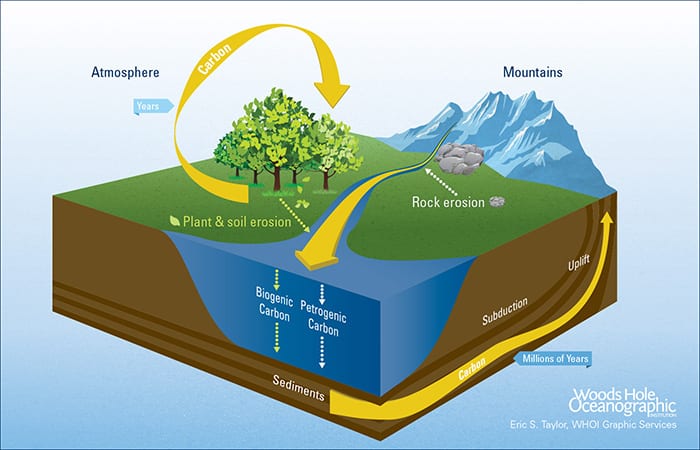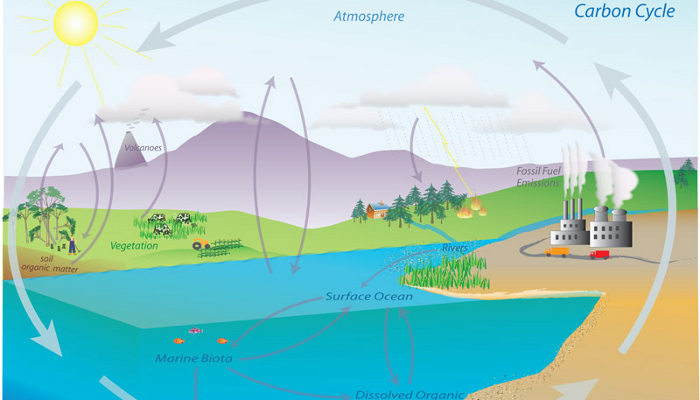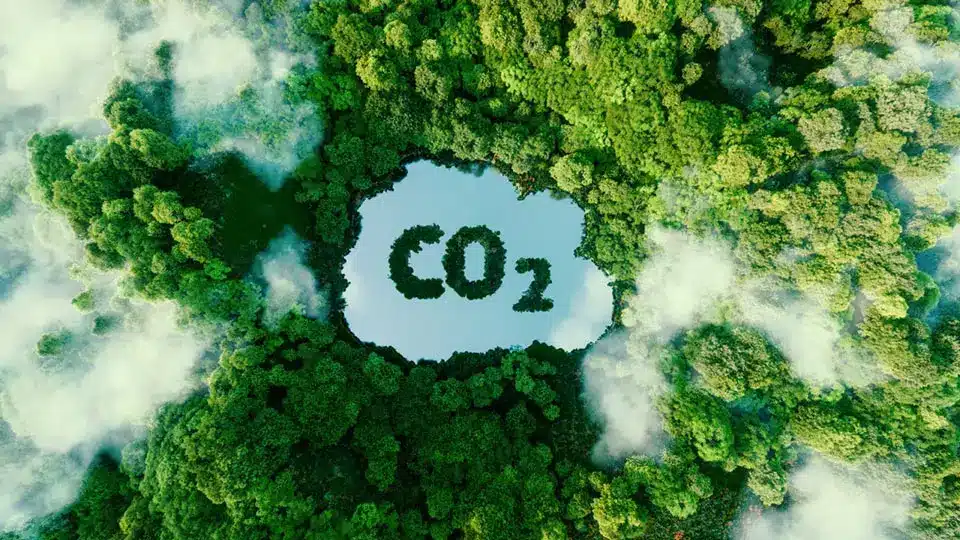Anúncios
Introduction to the Carbon Cycle
In the vast web of life on Earth, there exists a natural cycle vital for our planet’s survival. Often overlooked yet omnipresent, the carbon cycle is integral to sustaining life and maintaining a stable climate. This section delves deep into the complex world of this dynamic cycle, demystifying its mechanisms, its role in our environment, and its profound implications for climate change and sustainability.
Earth’s carbon cycle is an intricate system, balancing the give-and-take of carbon dioxide between the biosphere, atmosphere, oceans, and geosphere. This silent yet relentless process has been at work for billions of years, enabling life as we know it to flourish. We shall explore in detail how this cycle operates, the pivotal role it plays in our ecosystem, and the far-reaching impacts of its disruption.
Anúncios
The Role of Carbon in Earth’s Systems
Carbon is a fundamental building block of life and is integral to many natural processes. It is involved in photosynthesis, where plants and algae convert carbon dioxide and sunlight into oxygen and glucose. This essential function not only supports plant life but also forms the base of the food chain, sustaining herbivores, which in turn support predators. Without this carbon-based exchange, ecosystems would collapse.
Carbon is also a structural component of all living organisms. In proteins, fats, carbohydrates, and nucleic acids such as DNA and RNA, carbon atoms serve as the framework that holds these molecules together. It is no exaggeration to say that life as we know it would not exist without carbon at its core.
Anúncios
In geological terms, carbon contributes to the formation of fossil fuels, such as oil, coal, and natural gas. These fuels originate from the remains of ancient plants and marine organisms that, over millions of years, were buried under sediment and subjected to heat and pressure. The carbon trapped in this biomass becomes a dense, energy-rich substance, which has fueled human development but also led to the excessive release of greenhouse gases.
Beyond fossil fuels, carbon plays a significant role in the formation of rocks, especially limestone, which is made primarily of calcium carbonate. This process locks carbon away in solid form for millions of years, reducing the amount circulating in the atmosphere. The weathering of rocks and the formation of sediments in oceans also help cycle carbon from the land into long-term storage.
Oceans act as massive carbon sinks, absorbing carbon dioxide from the atmosphere. Once in the water, carbon dioxide reacts with water molecules to form carbonic acid, which can then convert into bicarbonate and carbonate ions. These compounds are used by marine organisms to build shells and skeletons, creating vast underwater stores of carbon in coral reefs and sediment layers.
Volcanic activity is another natural process through which carbon is cycled. Volcanoes emit carbon dioxide during eruptions, which adds carbon to the atmosphere. This geological carbon release, although smaller compared to human emissions today, has played a role in regulating Earth’s climate over geological time scales.
Soil is yet another vital component of Earth’s carbon system. Organic matter within soil, formed from decomposed plants and animals, acts as a reservoir of carbon. Proper soil management in agriculture can either deplete or enrich these carbon stores, making land use a key player in the carbon cycle.
In summary, carbon is interwoven into every aspect of the Earth’s systems. From the microscopic scale of molecular structures to the planetary processes of plate tectonics and ocean currents, carbon is continuously cycling and transforming. This fluidity allows Earth to sustain life, regulate climate, and evolve over time.
The Processes of the Carbon Cycle
The carbon cycle involves numerous stages and processes, each playing a different role in the movement of carbon throughout the Earth’s systems. These processes include:
- Photosynthesis – The process by which plants and algae convert carbon dioxide and sunlight into oxygen and glucose.
- Respiration – Animals and plants release carbon dioxide back into the atmosphere when breaking down glucose for energy.
- Decomposition – Dead organisms are broken down by bacteria and fungi, returning carbon to the soil and atmosphere.
- Combustion – The burning of organic materials, especially fossil fuels, releases carbon dioxide into the air.

Carbon Sequestration and Climate Impact
Carbon sequestration is the process by which carbon dioxide is captured and stored, either naturally or through human intervention. Forests, wetlands, and oceans are natural carbon sinks, while carbon capture and storage (CCS) technologies represent human-engineered solutions.
However, human activities have disrupted this balance. Deforestation, land use changes, and the burning of fossil fuels have increased atmospheric CO2 levels, exacerbating the greenhouse effect and contributing to global warming.
Climate Feedback Loops
A critical concern is the potential for climate feedback loops. As global temperatures rise:
- Permafrost may thaw, releasing stored carbon and methane.
- Ocean warming reduces CO2 absorption, weakening natural carbon sinks.
- Droughts reduce vegetation cover, lowering carbon uptake.
These feedbacks can accelerate climate change, making it even more vital to address carbon cycle disruptions.
Monitoring the Carbon Cycle
Scientists use remote sensing, satellite imaging, field studies, and atmospheric modeling to track carbon fluxes. Monitoring carbon sources and sinks allows researchers to understand the cycle’s behavior and predict changes under various climate scenarios. These tools are essential in identifying which ecosystems are effectively sequestering carbon and which are becoming sources of carbon emissions due to environmental degradation or human interference.

Remote sensing technologies, including satellite systems like NASA’s OCO-2 (Orbiting Carbon Observatory) and Japan’s GOSAT (Greenhouse Gases Observing Satellite), continuously measure atmospheric CO2 concentrations from space. These instruments provide high-resolution, global datasets that reveal both natural and anthropogenic emission patterns. The ability to monitor changes over time helps scientists validate climate models and refine predictions about future climate conditions.
Field-based measurements complement satellite data by offering on-the-ground verification. Researchers use tools like eddy covariance towers and soil sensors to monitor carbon exchanges between ecosystems and the atmosphere. These data points are crucial for understanding carbon cycling in forests, wetlands, grasslands, and agricultural systems.
Atmospheric modeling integrates satellite and field data to simulate carbon movement and storage at regional and global scales. These models allow scientists to project the effects of different policy scenarios or land use changes. For example, models can forecast how deforestation in the Amazon might affect atmospheric CO2 levels globally.
Long-term monitoring programs, such as NOAA’s Global Greenhouse Gas Reference Network, help establish baselines and track trends in atmospheric carbon concentrations. These consistent, reliable datasets serve as benchmarks for evaluating the effectiveness of climate mitigation efforts.
Emerging technologies are enhancing carbon cycle monitoring. Artificial intelligence and machine learning are now used to analyze vast amounts of data quickly, identifying patterns that might otherwise go unnoticed. Drones and autonomous ocean sensors are also being employed to collect real-time data in previously inaccessible regions.
Altogether, carbon cycle monitoring provides the empirical foundation for climate science. It informs decision-makers, shapes international agreements, and helps ensure accountability in emissions reporting. Without accurate monitoring, managing the global carbon balance would be impossible.
Human Responsibility and Carbon Management

Carbon management is a cornerstone of climate action. Strategies include:
- Afforestation and Reforestation – Planting trees to absorb CO2.
- Soil Carbon Management – Enhancing soil organic matter through regenerative agriculture.
- Carbon Pricing and Taxes – Encouraging businesses and individuals to reduce emissions.
- Transition to Renewable Energy – Reducing reliance on fossil fuels.
- Urban Planning and Public Transit – Designing cities to minimize carbon output.
Carbon Footprint and Individual Actions
Individuals also play a role in balancing the carbon cycle. Key actions include:
- Reducing meat consumption and food waste.
- Using energy-efficient appliances and vehicles.
- Supporting local and sustainable products.
- Advocating for policies that prioritize environmental sustainability.
Education and Global Collaboration
Global carbon management demands cooperation. International agreements like the Paris Accord emphasize collaborative efforts to limit global temperature rise. Education initiatives, from classroom programs to documentaries, raise awareness of the carbon cycle’s importance.
Countries, cities, corporations, and individuals must align their efforts to achieve net-zero emissions and restore the natural carbon balance.
Innovations and Technology in Carbon Management
As the urgency to address climate change grows, innovation and technology are proving to be critical tools in managing the carbon cycle. From high-tech carbon capture solutions to data-driven decision-making, the intersection of science, engineering, and sustainability is creating new possibilities for reducing atmospheric CO2 and restoring environmental balance.
Carbon Capture and Utilization (CCU)
While carbon capture and storage (CCS) focuses on removing CO2 from emissions and storing it underground, carbon capture and utilization (CCU) takes it a step further by turning captured carbon into useful products. Innovations include:
- Concrete curing – CO2 is injected into concrete during manufacturing to strengthen it and permanently sequester the carbon.
- Synthetic fuels – Captured CO2 is combined with green hydrogen to produce cleaner fuels.
- Carbon-based materials – Carbon is used to create carbon nanofibers or biodegradable plastics.
These technologies turn carbon from a waste product into a resource, offering promising paths to circular carbon economies.
Direct Air Capture (DAC)
Direct air capture is an emerging technology that removes CO2 directly from the atmosphere. Facilities use chemical solutions to extract carbon and store it safely or reuse it. Although still expensive, DAC is gaining traction as a long-term solution for hard-to-abate emissions.
Companies like Climeworks and Carbon Engineering are pioneering this field, building scalable facilities with the support of governments and climate-conscious investors.
Digital Tools and AI in Carbon Accounting
Artificial intelligence and big data are revolutionizing how we monitor and manage the carbon cycle. Digital platforms can:
- Track emissions across supply chains in real-time.
- Optimize transportation and energy systems to reduce CO2.
- Model climate scenarios for policy planning.
These tools enhance transparency and accountability, helping businesses and governments reach their sustainability targets.
Indigenous Knowledge and Carbon Stewardship
While technological advancements are vital, it’s equally important to recognize the role of Indigenous communities in carbon stewardship. For generations, Indigenous peoples have maintained forests, wetlands, and grasslands through practices that align with carbon sequestration.
Their knowledge includes:
- Controlled burning to prevent catastrophic wildfires.
- Agroforestry to combine food production with forest conservation.
- Spiritual and cultural guardianship of nature that fosters respect for ecological cycles.
Including Indigenous voices in climate policy and land management enhances both justice and environmental outcomes.
Urbanization and the Carbon Challenge
Urban areas contribute up to 70% of global CO2 emissions. As populations grow and cities expand, managing urban carbon becomes more urgent.
Key strategies include:
- Expanding public transit and non-motorized transport (bikes, walking).
- Promoting green buildings with efficient insulation, ventilation, and renewable energy.
- Incorporating green roofs and urban forests that absorb carbon and cool cities.
- Building smart grids to manage electricity use dynamically.
Sustainable urban design can dramatically reduce emissions while improving quality of life.
Oceans and the Blue Carbon Connection
While land-based carbon sinks are well known, oceans also play a critical role in the carbon cycle. Blue carbon refers to the carbon stored in coastal ecosystems like:
- Mangroves
- Seagrasses
- Salt marshes
These habitats are up to 10 times more efficient at sequestering carbon than forests. Protecting and restoring blue carbon ecosystems not only reduces CO2 but also safeguards biodiversity and coastal resilience.
International programs like the “Blue Carbon Initiative” work to integrate ocean-based solutions into global climate strategies.
Policy Pathways and Global Cooperation
Effective carbon management depends on ambitious and coordinated policies at all levels:
- Carbon pricing mechanisms like cap-and-trade or carbon taxes.
- Subsidies for clean energy and reforestation.
- Regulations limiting emissions from key sectors like transportation, agriculture, and industry.
- International funding for developing countries to support green transitions.
Agreements like the Paris Climate Accord set targets for emissions reductions, but achieving those goals requires consistent follow-through, transparent reporting, and equitable collaboration across nations.
Psychological and Social Aspects of Carbon Awareness
Addressing climate change isn’t just a technical challenge—it’s also a cultural and psychological one. Public understanding and behavior play a massive role in how societies adopt sustainable practices.
Studies show that:
- Community engagement and storytelling can motivate climate action.
- Eco-anxiety is real, especially among younger generations, and should be acknowledged.
- Climate justice demands that vulnerable communities receive resources to adapt and thrive.
Climate communication that is clear, hopeful, and inclusive can inspire lasting change at every level of society.
In conclusion, unveiling the carbon cycle is akin to unlocking a secret code to sustainability and climate control. As we peel back the layers of this extraordinary process, we uncover not only a fascinating world of natural science but also a roadmap for a sustainable future. From the microcosm of a single plant to the macrocosm of planet Earth, the carbon cycle presents us with the tools we need to tackle the challenges of the modern world.
Understanding this cycle is not merely academic—it is a call to action. Every effort to reduce emissions, protect forests, and shift toward renewable energy is a step toward restoring balance. By respecting and emulating nature’s blueprint, we can ensure a livable planet for future generations. 🌍🌳

